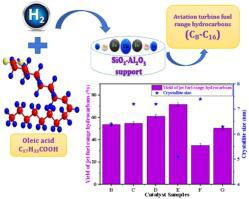Molecular Catalysis ( IF 3.9 ) Pub Date : 2021-01-05 , DOI: 10.1016/j.mcat.2020.111358 Afees A. Ayandiran , Philip E. Boahene , Sonil Nanda , Ajay K. Dalai , Yongfeng Hu

|
In this work, the synergistic effects of 1 wt.% Ti, 1 wt.% Zr, and Sn in the range of 0.5−2 wt.% on Fe(3)-Cu(13)/SiO2-Al2O3 catalyst were ascertained through extensive characterization and their subsequent evaluation for the production of aviation turbine fuel range hydrocarbons (C8-C16) via hydroprocessing of oleic acid. The largest surface area (571 m2/g) and pore volume (0.65 cm3/g) were obtained from the N2 physisorption analysis of 1 wt.% Sn-promoted catalyst (E). Cu2O and CuO were identified in the X-ray diffractograms (XRD) of all the catalysts except for catalyst E, which revealed only the peaks of Cu2O owing to the small particle size of CuO below the threshold of detection of XRD. X-ray photoelectron spectroscopy (XPS) analysis revealed the presence of both oxidized and reduced phases of Cu, Fe, Ti, Zr and Sn in their respective catalysts, with the highest and lowest atomic compositions of reduced Fe and CuO, respectively, detected in catalyst E; corroborating findings from XRD analyses. The relatively homogeneous dispersion of phases present in catalyst E (revealed by its smallest crystallite size of 5.1 nm) was also evidenced by the weakest metal-support interaction from the H2-TPR analysis of the same catalyst. Hydroprocessing of oleic acid using catalyst E at 320 °C under H2 pressure of 2.1 MPa and reaction time of 8 h resulted in the highest aviation turbine fuel range hydrocarbons selectivity of 76.8 % and yield of 71.7 %. This was due to its high metal dispersion, desirable textural properties and high oxophilic reduced iron content.
中文翻译:

Sn,Ti和Zr促进的双金属Fe-Cu / SiO 2 -Al 2 O 3催化剂上的油酸加氢处理,以生产航空发动机燃油范围的碳氢化合物
在这项工作中,Ti(1%),Zr(1%)和Sn(0.5-2%)对Fe(3)-Cu(13)/ SiO 2 -Al 2 O 3的协同作用通过广泛的表征来确定催化剂,并对其进行后续评估,以通过油酸加氢生产航空涡轮燃料范围的碳氢化合物(C 8 -C 16)。从1重量%Sn促进的催化剂(E)的N 2物理吸附分析获得最大表面积(571m 2 / g)和孔体积(0.65cm 3 / g )。铜2在除催化剂E之外的所有催化剂的X射线衍射图(XRD)中鉴定出O和CuO,由于CuO的小粒径低于XRD的检测阈值,因此仅揭示了Cu 2 O的峰。X射线光电子能谱(XPS)分析表明,在各自的催化剂中同时存在Cu,Fe,Ti,Zr和Sn的氧化相和还原相,并且分别在Fe和CuO中检测到最高和最低的原子组成。催化剂E;XRD分析的证实结果。H 2中最弱的金属-载体相互作用也证明了催化剂E中存在的相相对均匀分散(通过其最小的微晶尺寸为5.1 nm揭示)。-相同催化剂的TPR分析。使用催化剂E在320°C,H 2压力为2.1 MPa,反应时间为8小时的条件下对油酸进行加氢处理的结果是,航空涡轮机燃料范围内的烃选择性最高,为76.8%,产率为71.7%。这是由于其高的金属分散性,理想的组织特性和高的亲氧还原铁含量。











































 京公网安备 11010802027423号
京公网安备 11010802027423号